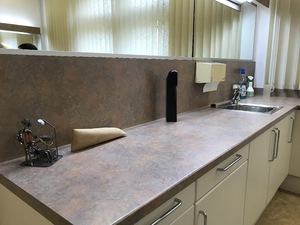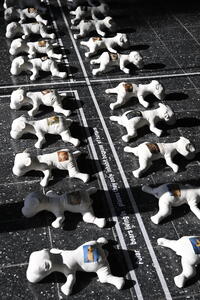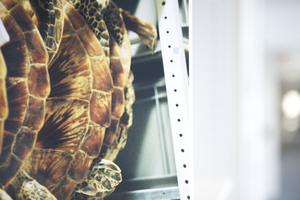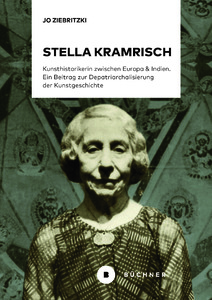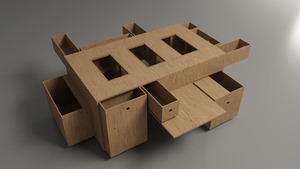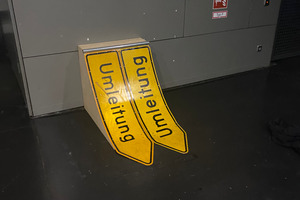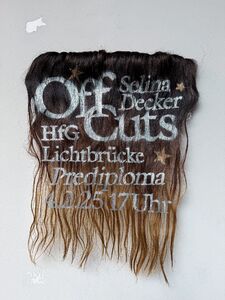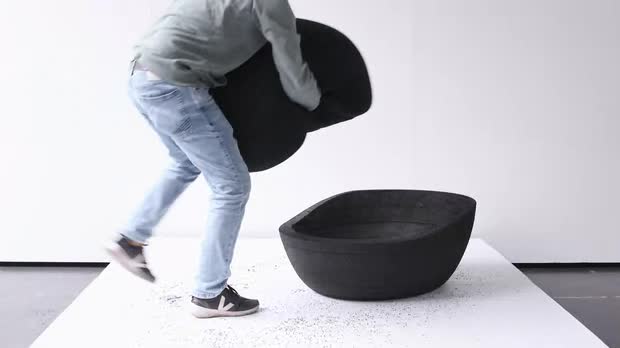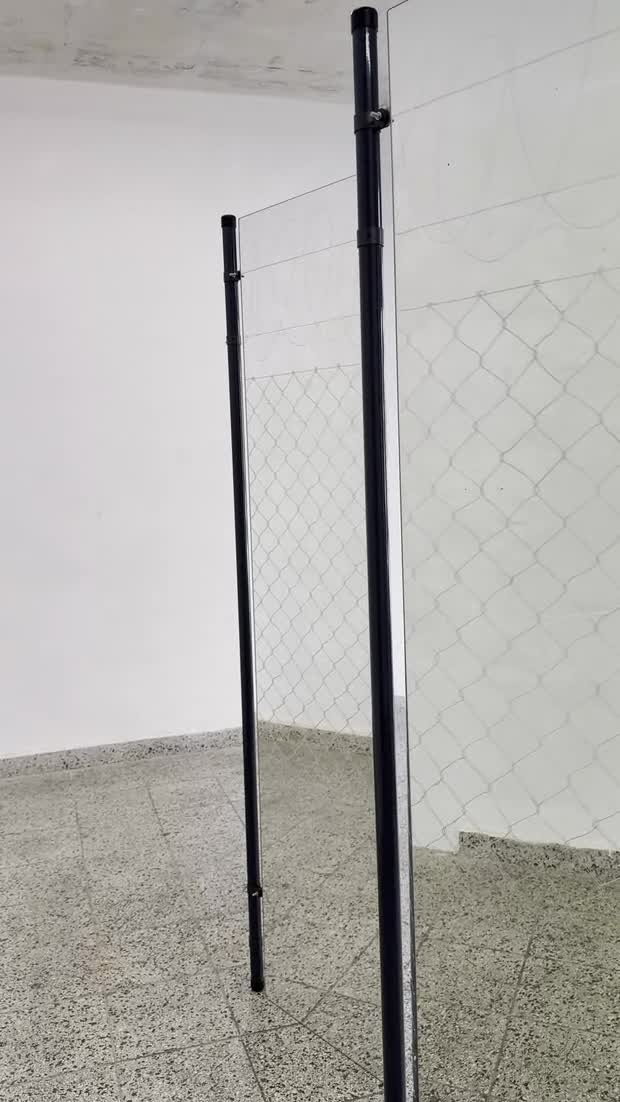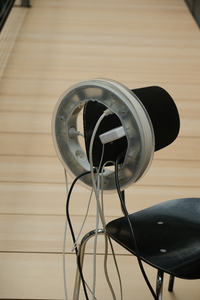approx. 3km, as the crow flies, from the Schauinsland Peak.
Benachbarte Sets (128)Alle Zusammenhänge anzeigen
Diese Sets wurden den gleichen Sets hinzugefügt wie das ausgewählte Set.
128 Inhalte
- Seite 1 von 11
(Un)Stopped Motion
- Titel
- (Un)Stopped Motion
- Titel (en)
- (Un)Stopped Motion
- Autor/in
- Beschreibung (de)
- In dieser interdisziplinären Arbeit wird der schleichende Prozess der Selbstkontrolle als Reaktion auf äußere Störungen untersucht. Ausgangspunkt ist die Angst, einen Fehler zu begehen, die nicht mit einem sichtbaren Eingriff beginnt, sondern sich langsam in das Bewegungsrepertoire des Körpers einschreibt, bis sie schließlich zum Stillstand führt.
Die Performance wird aus mehreren Perspektiven gefilmt. Diese Aufnahmen aus verschiedenen Blickachsen eines überwachenden Apparats, werden in der Installation projiziert.
- In dieser interdisziplinären Arbeit wird der schleichende Prozess der Selbstkontrolle als Reaktion auf äußere Störungen untersucht. Ausgangspunkt ist die Angst, einen Fehler zu begehen, die nicht mit einem sichtbaren Eingriff beginnt, sondern sich langsam in das Bewegungsrepertoire des Körpers einschreibt, bis sie schließlich zum Stillstand führt.
- Beschreibung (en)
- This interdisciplinary work examines the creeping process of self-control as a response to external disturbances. The starting point is the fear of making a mistake, which does not begin with a visible intervention, but slowly inscribes itself into the body's repertoire of movements until it finally leads to a standstill.
The performance is filmed from several perspectives. These recordings from different viewing angles of a surveillance device are projected in the installation.
- This interdisciplinary work examines the creeping process of self-control as a response to external disturbances. The starting point is the fear of making a mistake, which does not begin with a visible intervention, but slowly inscribes itself into the body's repertoire of movements until it finally leads to a standstill.
- Kategorie
- Typ des Projekts/Werks
- Schlagworte
- Datierung
- 24.09.2025 - 29.09.2025
- Mitwirkende
- Dank an
- Material
- Abmessungen
- 4x Screens 1,8x2,8 m
- Dauer
- 08:30
- Ort: Institution
- Ort
- Großes Studio, HfG Karlsruhe
Screen, HfG Karlsruhe
- Großes Studio, HfG Karlsruhe
- Stadt
- Land
- Titel
- (Un)Stopped Motion
- Projektleiter/in
- Semester
- Studiengang
- Typ der Abschlussarbeit
- Importiert am
- 21.10.2025
- Übergeordnete Sets
- 2
- Set enthält
- 2 4
Kunst in der Praxis
- Titel
- Kunst in der Praxis
- Untertitel
- Methoden des Ausstellens im Vergleich zwischen ärztlicher Praxis und Kunstmuseum
- Autor/in
- Beschreibung (de)
- In ärztlichen Praxen sind häufig künstlerische Objekte ausgestellt. Anders als im Museum ist die Begegnung mit diesen Objekten jedoch eher selten der Anlass für den Besuch der medizinischen Einrichtung. Die beiläufige Betrachtung der Kunstwerke ist vielmehr ein ästhetisches Nebenprodukt des eigentlichen Anliegens der Besucher*innen. Wie und warum werden überhaupt Kunstobjekte in ärztlichen Einrichtungen präsentiert? Lässt sich diese Präsentation mit musealen Ausstellungen vergleichen? Diesen Fragen wird in dieser Magisterarbeit nachgegangen und mittels Feldforschung und museumskritischer Einordnung begegnet.
- Kategorie
- Typ des Projekts/Werks
- Schlagworte
- Datierung
- 21.10.2021
- Dank an
- Sprache
- Abmessungen
- 123 Seiten (85 Seiten Text)
- Stadt
- Land
- Titel
- Kunst in der Praxis
- Projektleiter/in
- Semester
- Studiengang
- Typ der Abschlussarbeit
- Importiert am
- 13.10.2025
- Übergeordnete Sets
- 2
- Set enthält
- 0 6
Ambassadors
- Titel
- Ambassadors
- Titel (en)
- Ambassadors
- Untertitel
- 12 stories of artificial survival
- Untertitel des Projekts/Werks (en)
- 12 stories of artificial survival
- Autor/in
- Beschreibung (de)
- AMBASSADORS ist eine installative Sammlung, bestehend aus 120 Stofftieren, die das Verhältnis der Konzepte vom Natürlichen und Künstlichen anhand des Eisbären in menschlicher Gefangenschaft beleuchtet. Im Kampf um die Klimakrise ist der Eisbär zum Symbolbild der zu schützenden Natur geworden und hat sich als solches zum Repräsentanten in das kollektive Gedächtnis eingebrannt. KI-generierte Bilder, von denen jeweils 10 eine der 12 Geschichten in der Installation visualisieren, wurden einzeln auf die Rücken der 120 Stofftiere übertragen und gemeinsam in ein immersives Wimmelbild verwoben. So werden die Stofftiere in der Installation zu Botschaftern einer künstlichen Population und verlängern damit, ohne Lebewesen Leid zuzufügen, die Ketten an Abbildungen von Abbildungen von etwas, das mal natürlich war.
- Beschreibung (en)
- Ambassadors is an installation consisting of 120 stuffed animals that explores the relation between the natural and the artificial through the lens of the polar bear in human captivity. In the fight against the climate crisis, polar bears haves become a symbolic image of nature in need of protection—an image that has etched itself into the collective memory. Each set of ten AI-generated images represents one of the twelve stories depicted in the installation. These images were transferred individually onto the backs of the 120 stuffed animals and collectively woven into an immersive Wimmelbild. In this way, the stuffed animals once again become ambassadors of an artificial population—extending the chain of representations of representations of something that once was natural, without causing harm to living beings.
- Kategorie
- Schlagworte
- Mitwirkende
- Material
- Titel
- Ambassadors
- Projektleiter/in
- Semester
- Studiengang
- Typ der Abschlussarbeit
- Importiert am
- 29.09.2025
- Übergeordnete Sets
- 2
- Set enthält
- 0 8
The Violent Container
- Titel
- The Violent Container
- Titel (en)
- The Violent Container
- Untertitel
- Exhibition and handbook
- Untertitel des Projekts/Werks (en)
- Exhibition and handbook
- Autor/in
- Beschreibung (de)
- „The Violent Container“ konzentriert sich auf das kulturelle Phänomen des Käfigs und das Einsperren als Praxis, um Objekte oder Körper einzuschließen, zu kategorisieren, einzuschränken und sich anzueignen – sowie als Mittel, um sie zu sammeln, zu schätzen, zu bewahren und zu schützen.
Das Projekt umfasst eine Ausstellung und eine Publikation, die die verschiedenen Eigenschaften und Funktionen der sich wandelnden Formen des Käfigs untersuchen und dabei erforschen, wie Käfige nicht nur die Verwaltung lebender oder toter Körper und Objekte ermöglichen, sondern auch die Art und Weise bestimmen, wie wir sie wahrnehmen.
- „The Violent Container“ konzentriert sich auf das kulturelle Phänomen des Käfigs und das Einsperren als Praxis, um Objekte oder Körper einzuschließen, zu kategorisieren, einzuschränken und sich anzueignen – sowie als Mittel, um sie zu sammeln, zu schätzen, zu bewahren und zu schützen.
- Beschreibung (en)
- "The Violent Container" focuses on the cultural phenomenon of the cage, and caging as a practice to contain, categorise, restrict, and appropriate objects or bodies – as well as a tool to collect, treasure, preserve, and protect them.
The project comprises an exhibition and a publication that examine the various properties and functions of the cage’s shifting forms, exploring how cages not only enable the administration of living or dead bodies and objects, but also govern the ways in which we perceive them.
- "The Violent Container" focuses on the cultural phenomenon of the cage, and caging as a practice to contain, categorise, restrict, and appropriate objects or bodies – as well as a tool to collect, treasure, preserve, and protect them.
- Kategorie
- Typ des Projekts/Werks
- Schlagworte
- Mitwirkende
- Ort
- Rheinstetten, Karlsruhe
- Titel
- The Violent Container
- Projektleiter/in
- Semester
- Studiengang
- Typ der Abschlussarbeit
- Importiert am
- 21.09.2025
- Übergeordnete Sets
- 2
- Set enthält
- 0 14
Stella Kramrisch. Kunsthistorikerin zwischen Europa und Indien.
- Titel
- Stella Kramrisch. Kunsthistorikerin zwischen Europa und Indien.
- Untertitel
- Ein Beitrag zur Depatriarchalisierung der Kunstgeschichte
- Autor/in
- Beschreibung (de)
- Warum gab es keine bedeutenden Kunsthistorikerinnen? Das Buch „Stella Kramrisch“ sucht in der Kunstgeschichtsschreibung der letzten Jahrzehnte nach einer Antwort auf diese polemische Frage. Die Erklärung für das Fehlen von Kunsthistorikerinnen findet sich in den misogynen und patriarchalen Strukturen der Geschichtsschreibung. Um die Reproduktion ebendieser Strukturen zu unterbrechen, ist das Buch dem Werk und Wirken der Kunsthistorikerin Stella Kramrisch (1896 –1993) gewidmet.
Stella Kramrisch war in den 1920er bis 1940er Jahren eine gefragte Expertin für indische Kunst. Aufgewachsen und promoviert in Wien, lehrte sie ab den frühen 1920er Jahren an Universitäten in Bengalen. Sie argumentierte für die Eigenständigkeit des künstlerischen Wertes indischer Architektur, Skulptur und Malerei. Während ihrer Zeit in Bengalen verbreitete sie ihre Thesen durch wirkungsmächtige Ausstellungen und Publikationen in Europa. Möglich war das durch die Zusammenarbeit mit Institutionen wie dem Wiener Institut für Kunstgeschichte, Springers Handbuch Kunstgeschichte, der Reformbewegung und dem Warburg Institut. Warum wissen wir nichts von dieser Tänzerin zwischen Kulturen, der scharfen Beobachterin und poetisch präzisen Autorin? Das Buch zielt auf die Erschließung des Werkes, der Methoden und des Kunstbegriffs von Kramrisch ab.
- Warum gab es keine bedeutenden Kunsthistorikerinnen? Das Buch „Stella Kramrisch“ sucht in der Kunstgeschichtsschreibung der letzten Jahrzehnte nach einer Antwort auf diese polemische Frage. Die Erklärung für das Fehlen von Kunsthistorikerinnen findet sich in den misogynen und patriarchalen Strukturen der Geschichtsschreibung. Um die Reproduktion ebendieser Strukturen zu unterbrechen, ist das Buch dem Werk und Wirken der Kunsthistorikerin Stella Kramrisch (1896 –1993) gewidmet.
- Beschreibung (en)
- Why were there no great women art historians? The book “Stella Kramrisch” seeks an answer to this polemical question in the art historiography of the last few decades. The explanation for the absence of women art historians is found in the misogynistic and patriarchal structures of much history writing. To interrupt the reproduction of these very structures, the book focuses on the work and activities of the art historian Stella Kramrisch (1896-1993).
In Europe, Stella Kramrisch was a sought-after expert on Indian art from the 1920s to the 1940s. Raised and graduated in Vienna, she taught at universities in Bengal from the early 1920s. Central to her research was the argument for the autonomy of the artistic value of Indian architecture, sculpture, and painting. During her time in Bengal, she spread her theses through influential exhibitions and publications in Europe. This became possible through collaborations with institutions such as the Vienna Institute for Art History, Springer’s Handbook of Art History, the Reform Movement, and the Warburg Institute. Why do we know nothing of this dancer between cultures, a keen observer and poetically precise writer? The book aims to make Kramrisch’s works, methods, and concept of art accessible.
- Why were there no great women art historians? The book “Stella Kramrisch” seeks an answer to this polemical question in the art historiography of the last few decades. The explanation for the absence of women art historians is found in the misogynistic and patriarchal structures of much history writing. To interrupt the reproduction of these very structures, the book focuses on the work and activities of the art historian Stella Kramrisch (1896-1993).
- Kategorie
- Typ des Projekts/Werks
- Schlagworte
- Ort: Institution
- Titel
- Stella Kramrisch. Kunsthistorikerin zwischen Europa und Indien.
- Projektleiter/in
- Semester
- Studiengang
- Typ der Abschlussarbeit
- Importiert am
- 28.07.2025
- Übergeordnete Sets
- 2
- Set enthält
- 0 2
Topologie des Verschwindens
- Titel
- Topologie des Verschwindens
- Autor/in
- Beschreibung (de)
- Am Anfang steht nicht die Form, sondern die Haltung. Genau das ist das bewusste und kritische Bewusstsein für den Raum. Was bedeutet es, wenn Architektur verschwindet? Was bleibt übrig, wenn das Nützliche, Sichtbare und Funktionale entfernt wird? Genau an diesem Punkt beginnt der eigentliche reflexive Handlungsspielraum des Künstlers. Anders gesagt: Es öffnet sich ein Denkraum, in dem nach den Bedingungen des Seins gefragt, die wesentlichen Strukturen der Dinge erprobt und noch nicht geformte Möglichkeiten konfrontiert werden. Denn jeder Akt der Entfernung ist ein Akt, der die Bedingungen für latente Bedeutung und Gestalt offenbart. So erscheint im Verschwinden etwas Neues.
In jeder Phase dieser Arbeit spiegelt sich ein bewusster und reflektierender Eingriff wider – eine Art choreografierter Dialog mit Struktur, Erinnerung und Bedeutung. Das Entfernen von Strukturen, das Imaginieren von Kästen, die Transformation des Innenhofs – all diese Eingriffe sind Akte der Erkenntnis und kritische Selbstbefragungen des Raums: „Was bin ich, wenn ich nicht mehr funktioniere?“ Dass Architektur ihre Funktion verliert, bedeutet, dass sie in einen Zustand des Schweigens gerät, in dem sie sich selbst nicht mehr erklären oder zeigen kann. Diese Fragen führen ganz natürlich zu einer weiteren: Wenn Architektur schweigt – wer bringt dann ihre innere Erinnerung und Struktur zum Sprechen?
Diese Arbeit basiert auf einer Annahme: Ein Tisch, der einst angefertigt, aber nie ausgestellt wurde, hat lange Zeit im Depot des Museums verbracht. Nun wird dieser Tisch in die Mitte des Ausstellungsraums gebracht – ein symbolischer Akt der Öffnung der in der Struktur versiegelten Erinnerung und des Wiedererscheinens einer verstummten Form. Die Form dieses Tisches verweist jedoch auf die Struktur des Gebäudes, in dem er sich befindet. Mit anderen Worten: Der Tisch ist ein Wesen, das die Erinnerung der Architektur, zu der er gehört, verinnerlicht hat. Indem er aus dem Ursprung geschaffen wurde und in diesen Ursprung zurückkehrt, rechtfertigt der Tisch seine Existenz als bedeutungstragende Entität im Raum.
Den Tisch in die Mitte zu stellen – als Vermittler und Übersetzer der Geschichte – ist keine zufällige Entscheidung. Es ist eine Metapher für die Rückkehr zur Oberfläche, zum Ausdruck, zur Geste der Öffnung. Innerhalb der Struktur, die er widerspiegelt, wird der Tisch zur Schnittstelle zwischen Betrachter und Struktur, zwischen Erinnerung und Gegenwart. Er fordert Handlung – doch jede Handlung ist der Beginn einer Interpretation, die eine potenzielle Erzählung liest, und jede Öffnung ist ein erbetener Dialog.
Wenn Architektur nicht mehr funktioniert, schweigt sie wie eine vergessene Sprache, deren Worte verstummt sind. Doch künstlerisches Eingreifen bringt dieses Schweigen wieder zum Sprechen. Diese Arbeit versteht Architektur als Sprache – eine vergessene, verschüttete, zum Schweigen gebrachte Sprache, die durch das Denken des Künstlers wieder sprechen lernt. Was hier gezeigt wird, ist ein materiell verdichteter Denkprozess. Es ist eine Erzählung, die sich durch Entfernung, Rekonstruktion und symbolische Neueinschreibung entfaltet.
In diesem Sinne ist die Arbeit selbst eine Topologie des Denkens über das Verschwinden – eine künstlerische, selbstreflexive Karte, die erforscht, wie Erinnerung und Struktur, Form und Bedeutung miteinander in Beziehung stehen, wie sie verteilt werden und wie sie wieder zu einer Erzählung verbunden werden. Jede Linie, die sie bildet, ist eine Handlung, und jede Handlung ist ein Satz im inneren Dialog der Form.
- Am Anfang steht nicht die Form, sondern die Haltung. Genau das ist das bewusste und kritische Bewusstsein für den Raum. Was bedeutet es, wenn Architektur verschwindet? Was bleibt übrig, wenn das Nützliche, Sichtbare und Funktionale entfernt wird? Genau an diesem Punkt beginnt der eigentliche reflexive Handlungsspielraum des Künstlers. Anders gesagt: Es öffnet sich ein Denkraum, in dem nach den Bedingungen des Seins gefragt, die wesentlichen Strukturen der Dinge erprobt und noch nicht geformte Möglichkeiten konfrontiert werden. Denn jeder Akt der Entfernung ist ein Akt, der die Bedingungen für latente Bedeutung und Gestalt offenbart. So erscheint im Verschwinden etwas Neues.
- Kategorie
- Typ des Projekts/Werks
- Datierung
- 23.07.2025
- Technik/Verfahren/Formate
- digitale Modellstudie
- Titel
- Topologie des Verschwindens
- Projektleiter/in
- Studiengang
- Importiert am
- 23.07.2025
- Übergeordnete Sets
- 0
- Set enthält
- 0 7
rethinking public space
- Titel
- rethinking public space
- Titel (en)
- rethinking public space
- Autor/in
- Beschreibung (de)
- „rethinking public space“ ist ein Projekt, das sich mit Street-Skating und Skate-Kultur befasst und untersucht, wie Skateboarder öffentliche Räume neudenken und umgestalten können.
Das Projekt besteht aus einer Publikation mit Fotos von Street-Skate-Spots und Interviews. Es enthält ein Interview mit der Stadt Stuttgart, über den Bau von Skateparks, DIY-Parks und Skate-Stoppern, und ein zweites Interview mit einem Skateboarder und Content Creator aus San Diego, der über die Skate-Kultur, ihre Beziehung zur Öffentlichkeit und die kreativen Wege spricht, mit denen Skateboarder Herausforderungen überwinden.
Die Publikation funktioniert wie ein Daumenkino, das alle Skate-Spots aus dem gleichen Blickwinkel zeigt und die Bewegung des Grindens durch sie hindurch nachahmt, unterbrochen nur durch Skate-Stopper-Seiten. Darauf folgen die Interviews.
Die Publikation ist in ein mit Wachs versiegeltes, siebgedrucktes Stoffband mit dem Namen der Publikation eingewickelt.
Weitere Wachsbänder, die jeweils einen Auszug aus einem der Interviews zeigen, sind über die gesamte Ausstellung verteilt.
Ein weiteres Element des Projekts auf Wachsbasis sind die Skatestopper-Wachsrepliken, die den Skatestoppern in Karlsruhe nachempfunden sind und das Skateboarden ermöglichen, anstatt es zu verhindern.
Begleitend zur Publikation gibt es eine Rampe aus alten Straßenschildern und Holzabfällen sowie eine Rail aus einem alten Rutschen-Seitenteil. Diese Elemente sind eine Hommage an DIY-Skate-Spots und nutzen kostengünstige, leicht verfügbare Ressourcen.
- „rethinking public space“ ist ein Projekt, das sich mit Street-Skating und Skate-Kultur befasst und untersucht, wie Skateboarder öffentliche Räume neudenken und umgestalten können.
- Beschreibung (en)
- 'rethinking public space' is a project focusing on street skating and skate culture, as well as exploring how skateboarders can reuse and reshape public spaces.
The project consists of a publication containing photographs of street skate spots and interviews. There is one interview with a city official talking about the process of building skate parks, DIY parks and skate stoppers, and a second interview with a skateboarder and content creator from San Diego talking about skate culture, its relationship with the public, and the creative ways skateboarders overcome obstacles.
The publication functions as a flipbook, showing all the skate spots from the same angle and emulating the motion of grinding through them, interrupted only by skate stopper pages. These are followed by the interviews.
The publication is wrapped in a wax-sealed, screen-printed cloth band bearing the publication's name.
More wax bands, each showcasing an excerpt from one of the interviews, are spread throughout the exhibition.
Another wax-based element of the project is the skatestopper wax replicas, modelled on those found in Karlsruhe, which enable skateboarding rather than prevent it.
Accompanying the publication is a ramp made from scrap street signs and discarded wood, as well as a rail made from an old slide side piece. These elements pay homage to DIY skate spots and utilise affordable, readily available resources.
- 'rethinking public space' is a project focusing on street skating and skate culture, as well as exploring how skateboarders can reuse and reshape public spaces.
- Kategorie
- Typ des Projekts/Werks
- Schlagworte
- Datierung
- 02.07.2025
- Dank an
- Sprache
- Material
- Technik/Verfahren/Formate
- Siebdruck, Lumbecken, Folienplott,
- Abmessungen
- Breite: 195mm, Höhe: 140mm
- Ort: Institution
- Ort
- Unter der Lichtbrücke
- Stadt
- Land
- Titel
- rethinking public space
- Projektleiter/in
- Semester
- Studiengang
- Typ der Abschlussarbeit
- Importiert am
- 21.07.2025
- Übergeordnete Sets
- 1
- Set enthält
- 3 0
OffCuts
- Titel
- OffCuts
- Autor/in
- Beschreibung (de)
- Ich habe menschliches Haar als Material und Textil erforscht. Haare sind etwas zutiefst Persönliches, aber auch eine weithin verfügbare und oft weggeworfene Ressource. Im Rahmen meiner Recherchen habe ich das Material aus verschiedenen Blickwinkeln - wissenschaftlich, kulturell und künstlerisch - untersucht und gleichzeitig mit ihm gearbeitet, um Textilien und Teppiche mit verschiedenen Techniken herzustellen.
- Beschreibung (en)
- I explored human hair as a material and textile. Hair is something deeply personal, yet it is also a widely available and often discarded resource. Through my research, I examined the material from different perspectives - scientific, cultural, and artistic, while also working hands-on with it to create textiles and carpets using various techniques.
- Kategorie
- Typ des Projekts/Werks
- Schlagworte
- Datierung
- 04.02.2025
- Mitwirkende
- Material
- Ort: Institution
- Titel
- OffCuts
- Projektleiter/in
- Semester
- Studiengang
- Typ der Abschlussarbeit
- Importiert am
- 21.07.2025
- Übergeordnete Sets
- 1
- Set enthält
- 0 7
Float
- Titel
- Float
- Titel (en)
- Float
- Autor/in
- Beschreibung (de)
- Der Float Lounger, entworfen von Felix Reif und Finn de Bruyn, hebt den Sitzsack auf das Niveau eines vollwertigen Relaxmöbels.
Sowohl die Basis als auch das Kissen bestehen aus expandiertem Polypropylen. Der Einsatz dieses innovativen Materials, das in der Möbelproduktion nur selten verwendet wird, ermöglicht einen leichten, robusten und zu 100 % recycelbaren Sitz. Das mit expandierten Polypropylen-Perlen gefüllte Kissen passt sich jeder Körperform an, steigert die Entspannung und vermittelt dabei das Gefühl, an einem Sonntagabend in einem Schaumbad zu versinken.
- Der Float Lounger, entworfen von Felix Reif und Finn de Bruyn, hebt den Sitzsack auf das Niveau eines vollwertigen Relaxmöbels.
- Beschreibung (en)
- The Float lounger, designed by Felix Reif and Finn de Bruyn, elevates the bean bag to the level of a full-fledged piece of relaxation furniture.
The base and cushion are made of expanded polypropylene. The use of this innovative material, which is rarely found in furniture production, allows for a lightweight, resilient, and 100% recyclable seat. The cushion, filled with expanded polypropylene beads, adapts to every body shape enhancing relaxation while creating the sensation of sinking into a bubble bath on a Sunday evening.
- The Float lounger, designed by Felix Reif and Finn de Bruyn, elevates the bean bag to the level of a full-fledged piece of relaxation furniture.
- Kategorie
- Typ des Projekts/Werks
- Datierung
- 02.2025
- Mitwirkende
- Dank an
- Material
- Titel
- Float
- Importiert am
- 21.07.2025
- Übergeordnete Sets
- 1
- Set enthält
- 0 7
PARAVENT
- Titel
- PARAVENT
- Autor/in
- Beschreibung (de)
- Eine multidisziplinäre audiovisuelle Diplominstallation in Form eines Paravents aus handgravierten Spiegeln. Die Arbeit vereint Medienkunst und Produktdesign und präsentiert sich als Hybrid zwischen skulpturalem Kunstobjekt und funktionalem Möbelstück.
- Beschreibung (en)
- A multidisciplinary audiovisual diploma installation in the form of a folding screen made of hand-engraved mirrors. The work merges media art and product design, presenting itself as a hybrid between sculptural art object and functional piece of furniture.
- Kategorie
- Typ des Projekts/Werks
- Schlagworte
- Datierung
- 09.07.2025
- Mitwirkende
- Dank an
- Material
- Technik/Verfahren/Formate
- Gravur, Montage, Duft, Ultraschall- und Tieffrequenztöne
- Abmessungen
- H 2m x L 3m x B 1m
- Dauer
- infinite loop
- Ort: Institution
- Stadt
- Land
- Titel
- PARAVENT
- Projektleiter/in
- Semester
- Studiengang
- Typ der Abschlussarbeit
- Importiert am
- 21.07.2025
- Übergeordnete Sets
- 2
- Set enthält
- 0 4
Stromkreis
- Titel
- Stromkreis
- Titel (en)
- cirquit
- Autor/in
- Beschreibung (de)
- Die kreisförmige Mehrfachsteckdose gibt einem oft unbeachteten
Alltagsobjekt eine Stimme.
Der Kreis steht dabei sinnbildlich für Ordnung, Übersicht und Bewegung.
Anders als klassische Steckleisten, die sich in Ecken drängen lassen,
behauptet dieses Objekt seine Präsenz –
es verweigert das Verstecktsein und fühlt sich im Zentrum des Raums am
wohlsten.
Durch die mehrdirektionale Anordnung lassen sich Geräte aus allen
Richtungen mit Strom versorgen – eine Auflösung der linearen Nutzung
zugunsten räumlicher Offenheit.
Bis zu sieben Meter Kabel, die außen aufgewickelt werden, ermöglichen eine
flexible Nutzung in unterschiedlichsten Raumsituationen.
Die transparente Gestaltung der Seitenteile aus Plexiglas fördert ein neues
Bewusstsein für das Objekt – sie macht Funktion sichtbar und
Haltung greifbar.
So wird aus einem technischen Alltagsgegenstand ein
flexibler Begleiter, der sichtbar, nutzbar und verständlich
im Raum existiert.
- Die kreisförmige Mehrfachsteckdose gibt einem oft unbeachteten
- Beschreibung (en)
- The circular multiplug gives a voice to an often unnoticed everyday object. Here the circle symbolizes order, overview and movement. Unlike classic power strips, which can be pushed into corners, this object asserts its presence - it refuses to be hidden and feels most comfortable in the center of the room. The multi-directional arrangement allows devices to be supplied with power from all directions - a dissolution of linear use in favour of spatial openness. Up to seven meters of cable, which are wound up on the outside, enable flexible use in a wide variety of room situations. The transparent design of the Plexiglas side panels promotes a new awareness of the object - it makes function visible and attitude tangible. This turns an everyday technical object into a flexible companion that is visible, usable and understandable in the room.
- Kategorie
- Typ des Projekts/Werks
- Datierung
- 22.07.2025
- Titel
- Stromkreis
- Projektleiter/in
- Studiengang
- Importiert am
- 18.07.2025
- Übergeordnete Sets
- 1
- Set enthält
- 0 9
KLOTZSTUHL
- Titel
- KLOTZSTUHL
- Autor/in
- Beschreibung (de)
- Eine Studie des Stadtforschers William H. Whyte zeigt, dass es für Menschen ein positives Erlebnis ist, wenn sie Sitzmöbel selbst (um)positionieren dürfen. Der KLOTZSTUHL greift diesen Gedanken auf. Die Sitzfläche lässt sich verstellen, sodass sich der Stuhl an unterschiedliche Hangneigungen anpassen kann. Dadurch kann man ihn fast überall auf dem Hügel aufstellen. Er ist nicht fest installiert, aber durch seine "klotzige" Bauweise und das relative hohe Gewicht ist er auch nicht zum Mitnehmen gedacht.
Der KLOTZSTUHL wurde entworfen für Hänge in Parkanlagen wie beispielsweise dem MOUNT KLOTZ in der Günther-Klotz-Anlage in Karlsruhe. Er macht es möglich, auch an steilen Hängen bequem zu sitzen und die Aussicht auf den Sonnenuntergang mit einem kühlen Getränk zu genießen.
- Eine Studie des Stadtforschers William H. Whyte zeigt, dass es für Menschen ein positives Erlebnis ist, wenn sie Sitzmöbel selbst (um)positionieren dürfen. Der KLOTZSTUHL greift diesen Gedanken auf. Die Sitzfläche lässt sich verstellen, sodass sich der Stuhl an unterschiedliche Hangneigungen anpassen kann. Dadurch kann man ihn fast überall auf dem Hügel aufstellen. Er ist nicht fest installiert, aber durch seine "klotzige" Bauweise und das relative hohe Gewicht ist er auch nicht zum Mitnehmen gedacht.
- Beschreibung (en)
- A study by urban researcher William H. Whyte shows that people have a more positive experience in public spaces when they are allowed to (re)position seating furniture themselves. The KLOTZSTUHL embraces this idea. Its adjustable seat allows it to adapt to various slope angles, making it usable almost anywhere on a steep slope. It is not fixed in place, but due to its bulky design and quite heavy weight, it is also not meant to be carried away.
The KLOTZSTUHL was designed specifically for sloped areas in public parks, such as the MOUNT KLOTZ in the Günther-Klotz-Anlage in Karlsruhe. It makes it possible to sit comfortably even on steep hills, and to enjoy the view of the sunset with a cold drink.
- A study by urban researcher William H. Whyte shows that people have a more positive experience in public spaces when they are allowed to (re)position seating furniture themselves. The KLOTZSTUHL embraces this idea. Its adjustable seat allows it to adapt to various slope angles, making it usable almost anywhere on a steep slope. It is not fixed in place, but due to its bulky design and quite heavy weight, it is also not meant to be carried away.
- Titel
- KLOTZSTUHL
- Projektleiter/in
- Studiengang
- Importiert am
- 18.07.2025
- Übergeordnete Sets
- 1
- Set enthält
- 0 3

